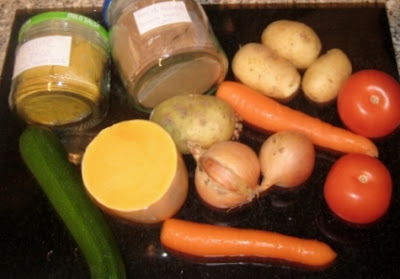Last weekend, my husband and I embarked on a short trip to Morocco, exploring the vibrant city of Tangier in the north. Let me talk about the incredible food we experienced. From the tantalizing couscous to the aromatic tagines and the bustling street food scene, every bite was a culinary delight. However, the highlight for me was the freshly squeezed orange juice—pure sunshine in a glass. I must confess, I indulged in at least two glasses a day throughout our four-day stay!

Since I bought special spice mixes for tagines and the spice Ras el Hanout in Tangier, I was inspired to cook something truly Moroccan. Luckily, I have a fantastic cookbook at home by Lesley Mackley called "The Book of North African Cooking," an old gem published in 1998, I acquired from our local library. It's filled with tantalizing recipes that capture the essence of Moroccan cuisine. One of my favorite recipes in this cookbook is Moroccan Couscous.
Moroccan couscous is a fantastic recipe that showcases how to make couscous from scratch and incorporates a hearty beef tagine. Traditionally, this dish calls for the use of seven vegetables, but since I didn't have all the ingredients on hand, I had to get a bit creative. I'll share the recipe here, along with the modifications I made while preparing this flavourful dish. As per the original recipe, it serves at least 6 people.
Let
me introduce you to the star player:
Ras
el Hanout is a North African spice blend that originates from Morocco. Its name
translates to "head of the shop" or "top-shelf," indicating
that it contains the best spices a seller has to offer. The exact composition
of Ras el Hanout varies from region to region and even from spice shop to spice
shop, but it typically includes a combination of warm and aromatic spices like
cumin, coriander, cinnamon, ginger, nutmeg, allspice, cloves, and turmeric.
This versatile spice blend is often used to season meats, tagines, couscous,
rice dishes, and more, adding depth of flavor and complexity to dishes.
Ingredients:
1 kg trimmed lamb cut into pieces (I used 300 g beef)
2 onions, chopped
55 g chickpeas, soaked overnight (I used 400 g canned butter beans)
1 tsp ground ginger
salt & pepper to taste
pinch saffron thread (I skipped this)
4 small turnips, cut into large pieces (I used 4 potatoes instead)
2 small carrots, chopped
450 g regular couscous (I used instant couscous)
25 g butter, melted
a little rosewater ( I didn't have)
55 g raisins
4 medium courgettes, halved length ways
1 butternut squash, peeled and cubed
2 tomatoes, quartered
2 tbsp each chopped fresh coriander and parsley (I used dried herbs)
Spices: 1 tsp tagine mix, 1 tbsp Ras el Hanout mix
Method:









No comments:
Post a Comment